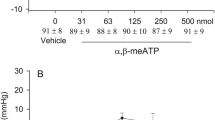Abstract
The objective of this study was to investigate the site of action of dipyrone in rat paw prostaglandininduced hyperalgesia. The intracerebroventricular (i.c.v.) injection of dipyrone had no effect on the hyperalgesic response to prostaglandins. In contrast, intraplantar (i.pl.) and intrathecal (i.t.) injections produced dosedependent analgesic effects. The analgesia observed following the intraperitoneal (i.p.), i.t., i.pl. or combined i.t. and i.pl. administration of dipyrone was abolished by pretreating the paws with L-NMMA (a nitric oxide synthase inhibitor) or methylene blue (MB, an inhibitor of soluble guanylate cyclase). These results support the suggestion that dipyrone-mediated antinociception results from a combined spinal and peripheral effect in the primary peripheral sensory neuron via stimulation of the arginine/cGMP pathway.
Similar content being viewed by others
References
Carlsson KH, Helmreich J, Jurna I. Activation of inhibition from the periaqueductal grey matter mediates central analgesic effect of metamizole (dipyrone). Pain 1986;27:373–90.
Carlsson KH, Jurna I. The role of descending inhibition in the antinociceptive effects of the pyrazolone derivatives, metamizole (dipyrone) and aminophenazone (“Pyramidon”). Naunyn-Schmiedebergs's Arch Pharmacol 1987;335:154–9.
Neugebauer V, Schaible HG, He X, Lucke T, Gundling P, Schmidt RF. Electrophysiological evidence for a spinal antinociceptive action of dipyrone. Agents Actions 1994;41:62–70.
Lorenzetti BB, Ferreira SH. Mode of analgesic action of dipyrone: direct antagonism of inflammatory hyperalgesia. Eur J Pharmacol 1985;114:375–81.
Ferreira SH, Lorenzetti BB, Campos DI. Induction, blockade and restoration of a persistent hypersensitive state. Pain 1990;42:365–71.
Duarte IDG, Santos IR, Lorenzetti BB, Ferreira SH. Analgesia by direct antagonism of nociceptor sensitization involves the arginine-nitric oxide-cGMP pathway. Eur J Pharmacol 1992;217:225–7.
Ferreira SH, Lorenzetti BB, Correa FMA. Central and peripheral antialgesic action of aspirin-like drugs. Eur J Pharmacol 1978;53:39–48.
Correa FMA, Graeff FG. Central mechanism of the hypertensive action of intraventricular bradykinin in the unanaesthetized rat. Neuropharmacology 1974;13:65–9.
Papir-Kricheli D, Frey J, Laufer R, Gilon C, Chorev M, Selinger Z, et al. Behavioural effects of receptor-specific substance P agonists. Pain 1987;31:263–76.
Laduron PM. Axonal transport of neuroreceptors: possible involvement in long-term memory. Neuroscience 1987;22:767–779.
Author information
Authors and Affiliations
Additional information
accepted by K. Brune
Rights and permissions
About this article
Cite this article
Lorenzetti, B.B., Ferreira, S.H. Activation of the arginine-nitric oxide pathway in primary sensory neurons contributes to dipyrone-induced spinal and peripheral analgesia. Inflamm Res 45, 308–311 (1996). https://doi.org/10.1007/BF02280997
Received:
Revised:
Accepted:
Issue Date:
DOI: https://doi.org/10.1007/BF02280997




